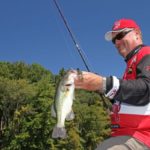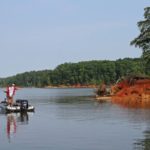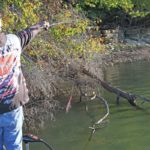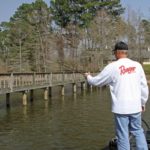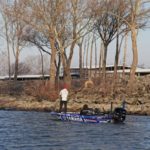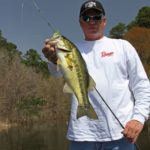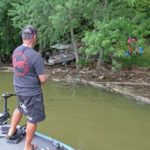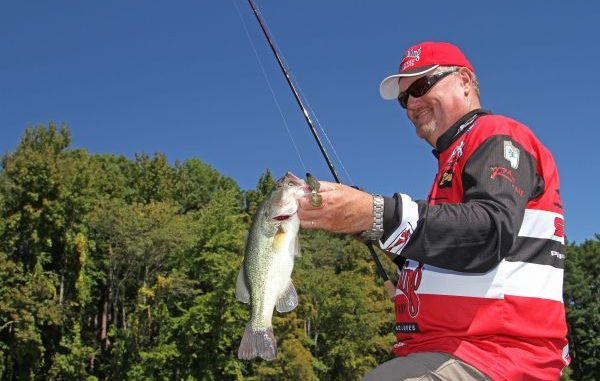
Catching more bass is often a matter of finding fish-friendly habitat by targeting shoreline disruptions. Touring pros share how they approach these fish-filled locations.
We stepped to the bow, angled the trolling motor and mentally prepared ourselves for prospecting a long stretch of bank.
Somewhere along this boundary of earth and water, we hoped to find a willing bass, and the usual areas of vegetation certainly got plenty of attention.
Amid the mundane, few features offered greater promise than a “break” — a distinct disruption in a continuous form of bank design.
Maybe it was a random break in a riprap shoreline or a residential area where a small paved ramp broke the contour. The landward terminus of an old roadbed certainly qualified here, while those transitional banks also offered distinct advantages.
The bottom line principle is this: Anything that breaks up a shoreline provides that fish-attracting “something different” feature. Such spots typically provide some type of solid structure representing shelter and feeding opportunities for bass.
Here’s a rundown of some common bank breakers that could be the difference between blanking and filling out your stringer.
Points
Louisiana Bassmaster Elite Series pro Dennis Tietje said points are the most obvious interruptions to a steady bank profile. Be it a grassy point with brush or those thick, orange knuckles of Toledo Bend clay, these pronounced extensions present bass-pleasing traits.
“There’s no doubt that points offer the first break in wind and current,” Tietje said. “In lakes or tidal waters it all works the same way. Most of the summer months you’re targeting points off the main lakes.”
As Tietje noted, a point’s inherent seclusion usually finds a few trees in the water: It could be healthy, standing cypress or various terrestrials sent tumbling by weather and erosion.
In any case, increased structure means increased productivity.
Standalone wood
Even without a point, logs, laydowns and stump clusters break up a bank’s continuity. And while Elite Series pro Greg Hackney has several tricks up his sleeve for this scenario, he’s fond of flipping and pitching Texas-rigged Strike King Rage Tail worms, that slither through the cover with sneaky, enticing movement.
Hackney said to give the entire piece of cover a chance to show its wares and don’t assume all the action necessarily waits at the branchy outside edge. The shadow line of a horizontally slanted tree trunk is a favorite hangout for quality bass.
Docks
The laydown logic also holds also for man-made platforms for fishing and boat tethering. The more advanced the design the better, but don’t overlook a skinny, featureless dock — especially one standing all by its lonesome.
Shade is shade, and where a dock stands as the only shoreline break for a long stretch you will probably find bass.
Work both sides of the walkway, all around the deep outer end and around boat hulls when you can reach. Give bass various looks — maybe some topwater action early in the morning and late in the afternoon, with a mix of squarebills, spinnerbaits and flipping baits (jigs and Texas-rigged plastics).
Shaky heads are real dock sleepers. Especially when summer’s heat makes for a tough midday bite, a slender worm standing up all vulnerable like is an easy sell.
And if fish are holding off the bottom, a dropshot can be just the ticket.
Riprap
Now when it comes to profoundly interrupting a natural bank, riprap brings some serious bass habitat with lots to offer.
Diagonal in slope, these piles of rock anchoring marina shorelines, bridge embankments and anything you don’t want washing away extend into the water several yards. This essentially gives fish a staircase to swim up and down the depth range as the day’s conditions dictate.
Moreover, the algae caking the shallower rocks is a baitfish magnet. And where there’s food there’s bass — and, as Elite Series pro Dean Rojas observed, these rocks are a good bet for primary targets and fallback plans.
“Even if you’ve never been to a lake, concentrate on a riprap bank and you’re going to do pretty good,” Rojas said. “Nothing provides cover like riprap because it’s usually close to deep water and there’s lots of (baitfish and crawfish) there.”
At first glance, riprap banks might appear to be homogenous masses; and yes, you might very well catch a fish anywhere along the stretch. However, there are almost always sweet spots worth discovering.
Rojas looks for random brush accumulations, windblown logs and debris, and any type of riprap point. The latter might be the entrance to a marina, the corner of a bridge embankment or even the edge of a break in the riprap.
Treat a riprap point like the ambush spot it is and present those crankbaits, spinnerbaits and jerk baits in the direction fish are used to seeing them.
“These are your high-percentage spots,” Rojas said. “There’s a change in the shoreline here, and anytime you have a transition in a bank there’s always going to be fish around there,” Rojas said.
Toledo Bend guide Stephen Johnston pointed out that riprap banks can be especially productive in the state’s southern regions, where bass and redfish mingle in tidal regions.
In this scenario, Johnston said he’d look for transitional shorelines where bulkheads meet riprap and riprap meets sand. Breaks in shoreline composition always seem to attract bass, if for no other reason than the depth variances they usually indicate.
“When there’s a change in the bank there’s typically a change out where you’re fishing,” Johnston said. “It might be a few inches or a couple of feet.”
Noting that riprap in tidal waters offer bass a bountiful mix of fresh and brackish forage, Johnston said one of his favorite baits for this deal is a V&M Lightning Blade with a V&M Thunder Shad trailer.
If he thinks a slimmer profile will coax indecisive fish into biting, he’ll lose the skirt and let the swimbait trailer close the sale.
Another of Johnston’s riprap producers is a small-profile squarebill crankbait like Strike King’s KVD 1.5. He’ll go with mullet or shad colors in brackish water or a perch pattern in fresh.
Boat ramps
FLW regional pro Phil Marks knows bass commonly hang around these cement or rubble launch sites, especially those little private deals tucked away in some quiet area.
Here, Marks said, bass find edges and hard, clean bottom. These areas also serve as natural transition areas, as their inherent sloping allows bass to easily adjust depth with the day’s conditions — sunny to cloudy, etc.
There’s also no denying the feeding opportunities: Chasing baitfish across a relatively flat surface is much easier than trying to catch them in vegetation or laydowns.
Marks typically probes such spots with small crankbaits — a Strike King 3XD for steeper ramps or a KVD 1.5 squarebill for flatter spots.
If he catches a fish and he’s confident the spot’s holding a few more — or if a bass strikes and misses the crankbait — Marks often hops or drags a Texas-rigged soft plastic like a Strike King Rage Bug or Menace across the ramp, working the lure along it’s sides and off the drop.
“During the mid-day, low-wind conditions we often have in (late summer), I might also work these spots with a drop shot,” Marks added.
Logging lanes
Okay, this one’s an old-school throwback, but Tietje said anglers in the know, will always spend sufficient time on the old logging float lanes cut into the swampy reaches off waterways like the Red, Atchafalaya, Mermentau and Calcasieu rivers.
Easily overlooked, these narrow passageways once saw loggers balancing in pirogues guiding their lumber bounty out of the mosquito- and moccasin-laden backwaters. Now these abandoned lanes offer potential big-bass habitat for those sharp enough to spot the opportunities.
“All the old rivers have lanes where (the lumber industry) floated cypress trees out of the swamps,” Tietje said. “This created very good bass spots. They may be only 10 to 20 feet wide, but they create water flow in and out of the swamps, and fish congregate there. It might only be a foot or 2 difference in depth, but where it enters the river it’s a break that fish will utilize.”
Creature baits are Tietje’s top choice for probing these lanes, but he’ll often start with a spinnerbait or a 1.5 squarebill to check for reaction bites. The edges of the lanes are usually best, but he’ll fire off a few centered casts to see if anyone’s lurking around the stumps common to the mouths of these swamp runs.
Something different
FLW Tour pro Dave Lefebre said when he’s pitching shorelines he looks for any oddity, anomaly or junky spot that might shelter fish.
One of his favorites is a gnarly raft of wind-driven wood and trash — the kind that usually appears after a rise in water level hauls a bunch of loose branches, logs and debris off the shorelines, and sends the flotsam out to where it gathers en masse and makes its way to the nearest windward shoreline.
“I like these spots because a lot of anglers don’t fish them,” Lefebre said. “The bass that hang out there don’t get a lot of pressure, so they’re easier to catch.”
So, whether it’s an obvious bank interruption or just some random, unattractive mass, cover is cover and it’s probably worth a few casts.
